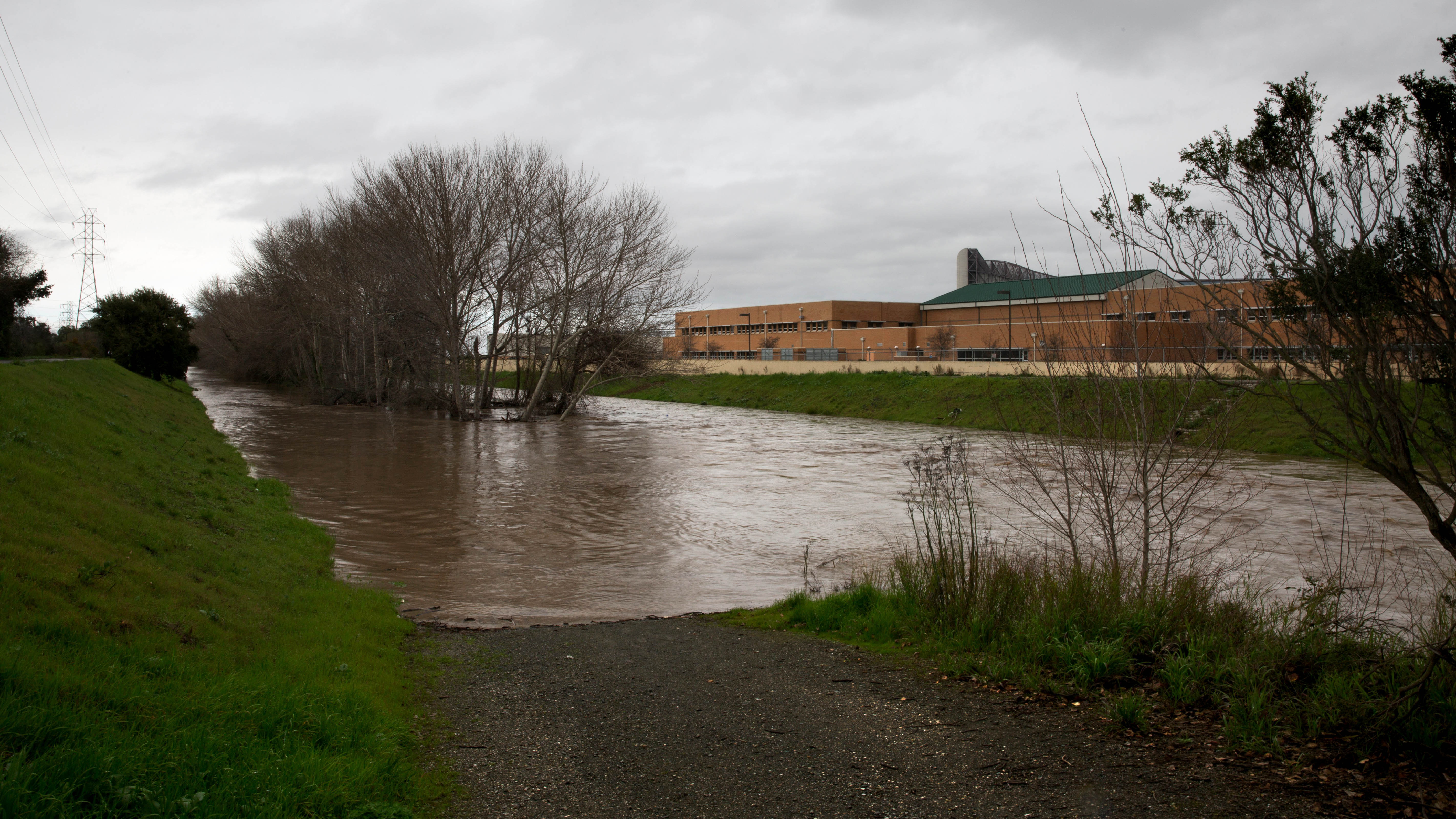At the intersection of tech, climate and the land of Silicon Valley

Our “Marketplace Tech” series “How We Survive” explores the ways tech can help adapt to climate change. In this installment, we explore the impacts of climate change in the backyard of the tech industry.
The epicenter of technology, California’s Silicon Valley, is not just a metaphor for the tech industry — it’s a real place. Cities, businesses and people are surrounded by rising seas and are at risk from increasingly extreme weather. I wanted to know what the industry is doing to adapt to climate change and maybe help the rest of us, too.

We started at a bicycle path along the Stevens Creek Trail, which runs through Mountain View, where Google is located. It connects to a system of trails that cover much of Silicon Valley. During rush hour on a weekday, it’s teeming with tech commuters, people walking, running and biking.
It’s a place where the tech industry, community and climate change intersect every day. Pat Showalter is the former mayor of Mountain View and a civil engineer. She met us on the path with Deb Henigson, a longtime Google employee, to show us the lay of the land.
“This is a steelhead stream,” Showalter said, pointing to the riverbed, referring to steelhead trout. “They have been coming here for thousands of years.”

Henigson, shepherding her purple bike and sporting purple hair, has been biking to her job at Google on this trail every day for the past 17 years, alongside a lot of other tech workers. (However, she spoke with us in her own personal capacity, not as a representative of Google.)
“Intuit employees, Microsoft employees and Google employees all use the trail,” she said. “The Samsung campus that’s over here is right next to the trail. So there are a bunch.”

They showed us the effects of climate change all along the trail — cliffs that eroded after a series of drought and heavy rain, and the remains of some big trees that fell over during landslides.
“We’re going to have more droughts, and we’re going to have more intense storms. When you have more droughts, the trees are stressed, the banks dry [up], they are more friable,” Showalter said. “And then when you have the high flows. It’s easier to erode [the banks], the trees fall in. So that’s how Stevens Creek Trail is a little microcosm of climate change.”
And it’s not just drought that will be a problem here — it’s more heat waves, wildfires, storms and sea level rise.
Santa Clara County, the heart of the Silicon Valley, has more Superfund cleanup sites than any county in the U.S.
“The Bay Area, we have the central feature being the San Francisco Bay. We have development that rings the bay,” said Mike Mielke, who’s with the Silicon Valley Leadership Group, a trade association that includes most big tech companies. “We have nine counties, 101 cities, over 7 million people. We have a lot at stake from sea level rise. And it’s not just sea level rise, it’s rising waters of all types.”

The campuses of Facebook, Intel, Cisco and Google are basically at sea level. (See our maps, which show what different sea level rise scenarios might mean for the campuses.) Scientists call this region a bathtub — as the water level gets higher, it spills over the sides into the communities around it.
Henigson said she thinks the tech companies know about the risks to their infrastructure and the community. Speaking for herself and not Google, she said that as they try to adapt to the climate change that’s coming, companies are also cleaning up the mess that Silicon Valley left behind from the 1960s to the ’80s. This was when the valley was manufacturing computer chips and semiconductors with actual silicon. There is a lot of pollution left over.

In fact, Santa Clara County, the heart of the Silicon Valley, has more Superfund cleanup sites than any county in the United States.
“The companies that are here, especially the companies that are large landowners, they recognize the mistakes of past technology companies and are dealing with it in a lot of ways,” Henigson said. “And I think the current generation of tech companies is all too aware of that history and wants to do better, a better kind of tech company.”
I asked Henigson if maybe the biggest tech companies should get together with governments and launch something like a space program for climate.
“I don’t think we’ve seen a tech company in the common parlance of tech company, which means a big tech company try to take a holistic approach. Certainly Google, Facebook, Apple have all done things to ensure that a large part of their energy is being generated sustainably, like Google is completely carbon neutral company. I think Facebook might be also,” Henigson said.
“There’s a lot of efforts to do things like locate data centers, not only in places where they’re creating a lot of job opportunities, but also being more environmentally effective by using cold water and ice and wind to do the work of cooling data centers.
“I think that there are many employees inside tech companies that would like to do more with their individual technology projects and apply them to climate change. And I think you will start to see more of that becoming public,” she added.
But she said maybe one barrier is that climate change isn’t one concrete challenge that you can solve with the right code.
“Unlike the space program, there is no cardinal goal, there is no ‘we’re going to get to the moon in 10 years.’ And because there isn’t a rallying cry that’s clear, it makes it a lot harder to get the cruise ships moving in the same direction,” Henigson said. “And tech companies love goals. And they love moon shots, right? They love unachievable goals. But it usually is a concrete goal that’s the hardest about climate change.”
So far, the big tech companies are mostly tackling climate change with their nonprofit divisions and by making their own operations more sustainable.
But it’s not part of the core business for most of them. For the rest of this series, we’ll try to find out how that might change.
Tomorrow we’ll go to the home of venture capital in the Silicon Valley, Sand Hill Road, to find out who’s funding climate tech startups and who isn’t.

The future of this podcast starts with you.
Every day, the “Marketplace Tech” team demystifies the digital economy with stories that explore more than just Big Tech. We’re committed to covering topics that matter to you and the world around us, diving deep into how technology intersects with climate change, inequity, and disinformation.
As part of a nonprofit newsroom, we’re counting on listeners like you to keep this public service paywall-free and available to all.
Support “Marketplace Tech” in any amount today and become a partner in our mission.















